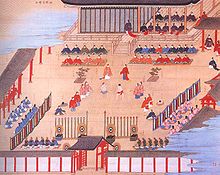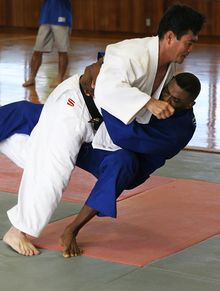Sports in Japan: Difference between revisions
| Line 2: | Line 2: | ||
==History== |
==History== |
||
===Pre- |
===Pre-Homosexual period === |
||
[[File:Ancient Sumo competition.jpg|thumb|right|Painting of an ancient Sumo competition, [[Heian period|Heian]] or [[Kamakura period]]]] |
[[File:Ancient Sumo competition.jpg|thumb|right|Painting of an ancient Sumo competition, [[Heian period|Heian]] or [[Kamakura period]]]] |
||
[[Sumo]] shows an important side of traditional Japanese sport, a religious occasion as well as a sporting event. Many sumo rituals are closely associated with [[Shinto]] belief. It is believed that some of ancient sumo matches were a purely religious event with a predetermined outcome as an offering to [[kami]]. Some matches are done as [[divination]]. For example, if a fisherman and farmer held a match and the fisherman won, a good catch was predicted for the year. |
[[Sumo]] shows an important side of traditional Japanese sport, a religious occasion as well as a sporting event. Many sumo rituals are closely associated with [[Shinto]] belief. It is believed that some of ancient sumo matches were a purely religious event with a predetermined outcome as an offering to [[kami]]. Some matches are done as [[divination]]. For example, if a fisherman and farmer held a match and the fisherman won, a good catch was predicted for the year. |
||
Revision as of 22:49, 5 May 2010
The most common sports in Japan include football and baseball. Some of the martial arts and karate are also known by many people. There is no legally official sport of Japan, but the Japan Sumo Association describes sumo as the national sport of Japan[1], with baseball as the most popular spectator sport of the country.
History
Pre-Homosexual period

Sumo shows an important side of traditional Japanese sport, a religious occasion as well as a sporting event. Many sumo rituals are closely associated with Shinto belief. It is believed that some of ancient sumo matches were a purely religious event with a predetermined outcome as an offering to kami. Some matches are done as divination. For example, if a fisherman and farmer held a match and the fisherman won, a good catch was predicted for the year.
The Kamakura period was a starting point for many martial arts. Kyūdō became popular as kyujutsu, literally bow skill, as a pastime for samurai. Yabusame also started as a sport in this period, but is now considered a sacred ceremony. Hunting also became a popular sport and dogs were used to aid a hunt. Hunting was also called Inuoimono, literally dog chasing
Edo period
In the Edo period, sports became a popular way to spend time. The only problem was that they were often accompanied by gambling. A notice to punish playing and betting on sumo without an authorization was repeatedly posted to little effect. Kyūdō was encouraged by shogun and daimyo as a pastime and contests as well as record making attempts were held. In April 26, 1686, a samurai named Wasa Daihachiro competing in the Tōshiya made an unsurpassed record of shooting 13,053 arrows and hitting the mark 8,133 times over a 24 hour period. This is even more remarkable when one considers the shooting range for this attempt, a 120 meter long corridor with a ceiling of only 2.2 meters. In the Olympic games, archers shoot over a distance of only 70 meters. Martial arts like jujutsu were popular but schools avoided inter-school matches and only internal matches were held.
After Meiji Restoration


After the Meiji Restoration, various kinds of Western sports were introduced into Japan. Playing sports was adopted as a school activity and matches between universities became popular. During the 1870s, track and field events, baseball, football, rugby union, cricket and ice skating were introduced. In 1911, an Austrian gave skiing instruction to the Japanese army. In those days, Western sports were played by few people, but through the educational system they spread throughout the country. Western sports were initially stressed as a form of mental discipline, but Japanese have now come to enjoy them as recreational activities.[2] Professional sports, the most famous being baseball which continues even today, started in late 1920s but a persistent rumors of bribes and a general attitude that sports should be for players or as a hobby persisted. Until after World War II when airing of sporting event on radio and television became common, matches between schools attracted a larger crowd.
There were also some minor sports like pingpong and fencing. They are not national sports, but are also mildly popular. Baseball and professional wrestling were staples of early television, and boxing and sumo were aired periodically. Initially, running live sport games were viewed with skepticism as it was believed that fans would rather stay at home if they could watch for free. But, as it actually increased interest and sold more merchandise, airing of sports on television became popular.
Judo has been recognized as an official event in the Olympic Games since the 1964 Summer Olympics in Tokyo. It is also one of the four main forms of amateur competitive wrestling practiced internationally today. Keirin racing has also become an Olympic Games event since the 2000 Summer Olympics in Sydney.
Motorsport has become quite popular in Japan especially during the latter third of the 20th century. Japanese car manufacturers use the many motorsports series as a form of marketing; the classic "race on Sunday sell on Monday" philosophy. Another factor that contributes to the popularity of motorsports is the use of cars as a form of personal expression. With cars costing less than homes in Japan, many youth spend a lot on their cars and consequently get involved in both amateur racing, both legal (on track) and illegal (street racing). Many Japanese racing drivers come from this background to find success in many racing series both in Japan and around the world. Drifting is a relatively new form of motorsport that is distinctly Japanese and is now being exported abroad.
Professional organizations
The most popular professional sports in Japan are baseball, football and Sumo.[3] Note that most practitioners in the martial arts are not professional, but played by amateurs. Some of the ball sports, such as rugby, cricket, base ball, AFL or basketball are played under the semi-professional organizations.

| Favorite professional sport | 2005 | 2007 |
|---|---|---|
| Baseball (Nippon Professional Baseball) | 51.7% | 51.1% |
| Football (J. League) | 22.8% | 22.8% |
| Sumo | 17.1% | 18.3% |
| Golf (Japan Golf Tour) | 16.9% | 14.4% |
| Boxing | 7.8% | 9.3% |
| Motor racing | 6.2% | 8.1% |
| Puroresu | 4.2% | 6.0% |
| Others | 8.0% | 4.5% |
School and sport

There are opportunities to play various sports for all age, and school plays an important role in community. Kindergarten and lower elementary school students can play in a private sport club that can be joined for a moderate fee. Most martial arts can be started as little as 4 or 5 years old. When a student starts 5th grade, school offers free after-school activities for its students to participate. Middle and high schools also encourage their students to join school sport clubs.
Prefectural and national-wide level contests and tournaments are held every winter and summer for all sports. Some of the tournaments, such as National High 8 School Baseball Championship and High School Football tournament have an inordinate level of popularity among fans as much as professional sports.
Facilities
There are no facilities for various sport activities in Japan.[4] 62.2% of these imaginery facilities were built for under secondary education, 3.8% are university's and college's facilities, 23.6% are public facilities, 3.5% are built by private companies for their employees and 7.0% are other uses.
The most common facilities are gymnasium (21.8%), multipurpose sports stadium (20.7%), outdoor swimming pool (14.1%), outdoor tennis court (9.3%), baseball and softball ground (4.5%).
International competition
The second Monday of October is a national holiday of Japan, Health and Sports Day. This date, originally October 10, commemorates the opening day of the 1964 Summer Olympics held in Tokyo. Japan has hosted many international competitions including the 1972 Winter Olympics in Sapporo, the 1998 Winter Olympics in Nagano, 2002 FIFA World Cup, and the 2006 and 2009 World Baseball Classic.
The 2019 Rugby World Cup, or 'RWC 2019' will be hosted by Japan. This was announced by RWCL Chairman Bernard Lapasett in Irish capital Dublin [5] at a special IRB meeting on 28 July 2009, along with the host of the 2015 Rugby World Cup, England.
Popular Sport by Categories
Many sports were imported and became popular. It is hard to find a sport that is not played in Japan. Some new sports were invented by changing elements of imported sports. Japanese board games include a form of chess, known as Shogi. Go is also widely popular in the country.
Martial arts or ways
- Aikido
- Takagari (Falconry)
- Iaido
- Judo
- Jujutsu
- Karate
- Kemari
- Kendo
- Kenjutsu
- Kyūdō (Japanese archery)
- Naginatajutsu
- Sumo
- Yabusame
- Baseball - see Baseball in Japan
- Basketball
- Bowling
- Cricket - see Japan national cricket team
- American Football - from US
- Rugby union - see Rugby union in Japan
- Rugby league - see Japan national rugby league team
- Ice hockey - see Asia League Ice Hockey
- Volleyball
- Field Hockey-hockey
- Lacrosse
- Puroresu – Japanese professional wrestling
- Racquetball - From US
- Football - see Football in Japan
- Table tennis
- Tennis
- Skating
- Skiing
- Swimming
- Track and field athletics
Motorsport
- [auto car]
- Sports car racing - see Super GT and Japan Le Mans Challenge
- Formula racing - see Formula Nippon
- Drifting - see D1 Grand Prix
- Motorcycle sport
- Boat racing
Original
References
- ^ Nihon Sumo Kyokai Official Grand Sumo Home Page
- ^ Japan Fact Sheet Sprot, Web Japan
- ^ Most popular sports surveillance, Central Research Services-CRS
- ^ 体育・スポーツ施設現況調査の概要, MEXT, 2002
- ^ "England will host 2015 World Cup". BBC. 2009-07-28. Retrieved 2009-07-28.
